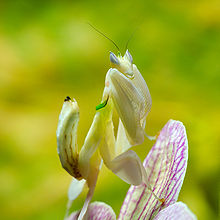Orchid mantis
| Hymenopus coronatus | |
|---|---|
 |
|
| Sub-adult female | |
| Scientific classification | |
| Kingdom: | Animalia |
| Phylum: | Arthropoda |
| Class: | Insecta |
| Order: | Mantodea |
| Family: | Hymenopodidae |
| Genus: | Hymenopus |
| Species: | H. coronatus |
| Binomial name | |
|
Hymenopus coronatus Olivier, 1792 |
|
| Synonyms | |
|
H. bicornis (Stoll) |
|
H. bicornis (Stoll)
Hymenopus coronatus, also called H. bicornis, is a mantis from the rain forests of Southeast Asia. It is known by various common names including walking flower mantis and (pink) orchid mantis. It is one of several species known as flower mantises from their resemblance and behaviour. In the wild, H. coronatus can be found in Malaysia.
This species is characterized by brilliant colouring and a structure finely adapted for camouflage, mimicking parts of the orchid flower. The four walking legs resemble flower petals, the toothed front pair being used as in other mantises for grasping prey.
H. coronatus shows some of the most pronounced sexual dimorphism of any species of mantis; males can be less than half the size of females.
First-stage nymphs mimic bugs of the family Reduviidae, which have a powerful bite and are foul tasting.
The mantis can change its colour between pink and brown, according to the colour of the background.
Hymenopus coronatus is found in the rain forests of South-East Asia, including Malaysia, Myanmar, Thailand and Indonesia.
Hugh Cott quotes an account by Nelson Annandale of Hymenopus coronatus which he reports hunts on the flowers of the "Straits Rhododendron", Melastoma polyanthum. The nymph has what Cott calls "Special Alluring Coloration", where the animal itself is the "decoy". The insect is pink and white, with flattened limbs with "that semi-opalescent, semi-crystalline appearance that is caused in flower-petals by a purely structural arrangement of liquid globules or empty cells". The mantis climbs up and down the twigs of the plant until it finds one that has flowers. It holds on to these with the claws of its two rearmost pairs of legs. It then sways from side to side, and soon various small flies land on and around it, attracted by the small black spot on the end of its abdomen which resembles a fly. When a larger Dipteran fly, as big as a house fly, landed nearby, the mantis at once seized and ate it.
...
Wikipedia
